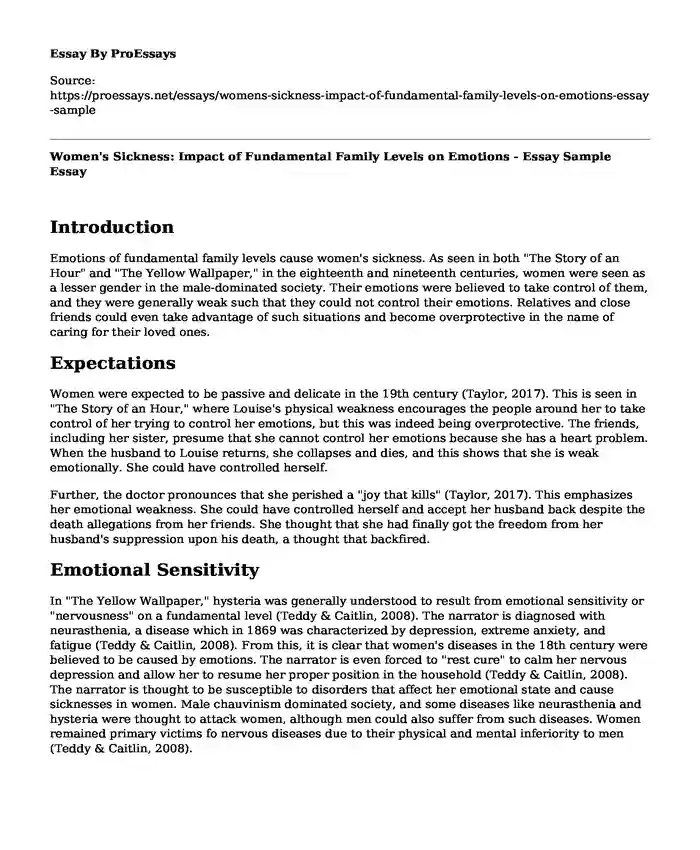Introduction
Emotions of fundamental family levels cause women's sickness. As seen in both "The Story of an Hour" and "The Yellow Wallpaper," in the eighteenth and nineteenth centuries, women were seen as a lesser gender in the male-dominated society. Their emotions were believed to take control of them, and they were generally weak such that they could not control their emotions. Relatives and close friends could even take advantage of such situations and become overprotective in the name of caring for their loved ones.
Expectations
Women were expected to be passive and delicate in the 19th century (Taylor, 2017). This is seen in "The Story of an Hour," where Louise's physical weakness encourages the people around her to take control of her trying to control her emotions, but this was indeed being overprotective. The friends, including her sister, presume that she cannot control her emotions because she has a heart problem. When the husband to Louise returns, she collapses and dies, and this shows that she is weak emotionally. She could have controlled herself.
Further, the doctor pronounces that she perished a "joy that kills" (Taylor, 2017). This emphasizes her emotional weakness. She could have controlled herself and accept her husband back despite the death allegations from her friends. She thought that she had finally got the freedom from her husband's suppression upon his death, a thought that backfired.
Emotional Sensitivity
In "The Yellow Wallpaper," hysteria was generally understood to result from emotional sensitivity or "nervousness" on a fundamental level (Teddy & Caitlin, 2008). The narrator is diagnosed with neurasthenia, a disease which in 1869 was characterized by depression, extreme anxiety, and fatigue (Teddy & Caitlin, 2008). From this, it is clear that women's diseases in the 18th century were believed to be caused by emotions. The narrator is even forced to "rest cure" to calm her nervous depression and allow her to resume her proper position in the household (Teddy & Caitlin, 2008). The narrator is thought to be susceptible to disorders that affect her emotional state and cause sicknesses in women. Male chauvinism dominated society, and some diseases like neurasthenia and hysteria were thought to attack women, although men could also suffer from such diseases. Women remained primary victims fo nervous diseases due to their physical and mental inferiority to men (Teddy & Caitlin, 2008).
Conclusion
From both stories "The Yellow Wallpaper" and "The Story of an Hour," it can be deduced that their emotions caused women's sicknesses. Louise dies upon realizing that her husband is back. She cannot live anymore without the freedom that she had just got. On the other hand, the narrator of "The Yellow Wallpaper," being a young mother, suffers from neurasthenia, and she has to take a "rest cure" for recovery. She might not have been ill at the beginning of the story. Still, as she gets depression, she starts showing symptoms of the disease, which is finally diagnosed with upon medical examination. It is from these two cases that we conclude that women's sicknesses were caused by emotions on fundamental family levels.
Cite this page
Women's Sickness: Impact of Fundamental Family Levels on Emotions - Essay Sample. (2023, Nov 16). Retrieved from https://proessays.net/essays/womens-sickness-impact-of-fundamental-family-levels-on-emotions-essay-sample
If you are the original author of this essay and no longer wish to have it published on the ProEssays website, please click below to request its removal:
- Abraham Lincoln's Biography
- The Case Study of Autism Paper Example
- Rock Band Concert Report
- Essay Sample on US History up to 1876
- Essay Example on Vivid Tones and Sacrifice in Helmet for My Pillow
- Essay on Cross-Cultural Communication in Romantic Relationships: A Study of Early Stages
- Paper Example on 5 U.S. Divisions in the D-Day Invasion of Normandy







